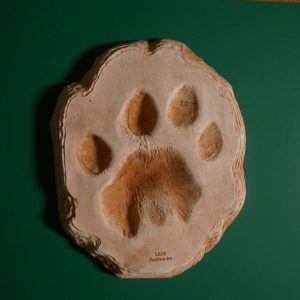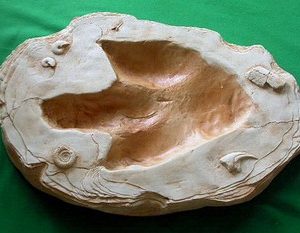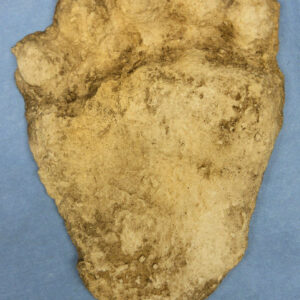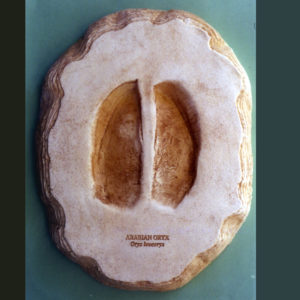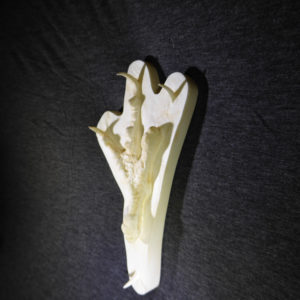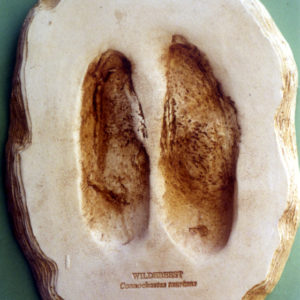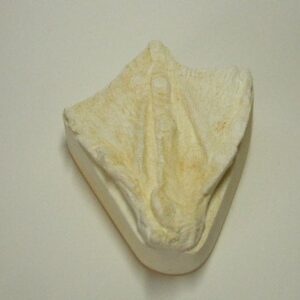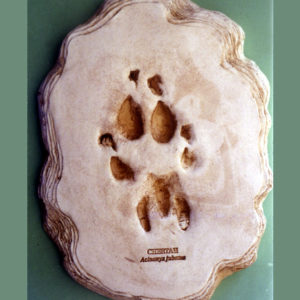All items sold on this website are polyurethane resin replicas, made in USA. No real or natural bone is available on this site.
Tracking animals is the art of interpreting signs like footprints, natural paths and nibbled plants. All of these clues can help discover what animal has recently been in a certain area.
These life-size tracking animal footprints can be filled with clay or plaster. Use the animal track casts as instructional aids.
You can press into moist sand or dirt to make animal track prints. Students can cast tracks for displays that they can share and bring home. Hands-on inquiry learning for ages 8-adult.
You can even cast these fabulous prints using Plaster of Paris for an exciting take-home project.
-
African Leopard Footprint Cast
$22.00The African Leopard (Panthera pardus pardus) is the nominate subspecies of the leopard, native to many countries in Africa. It is widely distributed in most of sub-Saharan Africa, but the…
-
African Lion Footprint Cast
$22.00The African Lion is a large cat of the genus Panthera, native to Africa and India. It’s skull frontal region is usually more depressed and flattened and has a slightly…
-
Allosaurus Dinosaur Large Footprint
$138.00Allosaurus was a large bipedal predator. Its skull was light, robust, and equipped with dozens of sharp, serrated teeth. Relative to the large and powerful legs, its three-fingered hands were…
-
American Black Bear Negative Footprint
$22.00American black bears often mark trees using their teeth and claws as a form of communication with other bears, a behavior common to many species of bears.
-
American Black Bear Negative Handprint
$22.00The claws are short and rounded, being thick at the base and tapering to a point. Claws from both hind and front legs are almost identical in length, though the…
-
American Crow Negative Footprint
$10.00The American Crow ranges over much of North America. This species is an omnivore, with a diet consisting of fruits, grains, insects, small vertebrates and carrion. Crows are a perching…
-
American Mink Footprint
$10.00Mink tracks can be found near streams as they are strongly associated with water. The front feet of mink tracks are larger and almost as wide as long. They have…
-
American Mink Negative Footprint
$10.00The American mink or Neovison vison is a semi-aquatic species of mustelidae native to North America, though human intervention has expanded its range to many parts of Europe and South…
-
Arabian Oryx Footprint Cast
$22.00Arabian Oryx have an unusual circulation system in their head. They are able to cool the blood flowing to their brain through the capillaries in their nose as they breathe….
-
Armadillo Footprint Cast Replica
$12.00Armadillos are characterized by a leathery armor shell and long, sharp claws for digging. They have short legs, but can move quite quickly.
-
Bald Eagle Negative Footprint
$22.00The Bald Eagle beak, feet and irises are bright yellow. The legs are feather-free, and the toes are short and powerful with large talons.
-
Bengal Tiger Footprint Cast
$22.00The greatest skull length of a Bengal Tiger is 13.8 in. in males and 11.5 in. in females. It has exceptionally stout teeth. Its canines are 3.0 to 3.9 in….
-
Black Bear Negative Footprint
$22.00Black Bear claws are short and rounded, being thick at the base and tapering to a point. Claws from both hind and front legs are almost identical in length, though…
-
Blue Jay Negative Footprint
$10.00The Blue Jay ranges through most of eastern North America. This species is omnivorous feeding on a variety of seeds, berries, insects and small vertebrates. Like its larger relatives, the…
-
Blue Wildebeest Footprint Cast
$22.00The Blue Wildebeest, a gregarious, herd-dwelling species, is one of the most abundant of the African bovids. During dry seasons, Wildebeest will make long migrations with individuals numbering into the…
-
Bobcat Baby Footprints Replica
$10.00Its spotted patterning acts as camouflage. The Bobcat or Lynx rufus ears are black-tipped and pointed, with short, black tufts. Generally, an off-white color is seen on the lips, chin,…
-
Bobcat Negative Footprint Replica
$10.00Though the Bobcat or Lynx rufus prefers rabbits and hares, it hunts insects, chickens, geese, other birds, small rodents, and deer. Prey selection depends on location and habitat, season, and…
-
California Dinosaur Footprint Plaque
$15.00The Coelurosaurs tracks are estimated to be 170 million years old. They were found in 1950 in the eastern Mojave by James Evans. He identified some of the impressions in…
-
Canadian Goose Negative Footprint
$10.00Like most geese, the Canadian goose is primarily herbivorous and normally migratory; often found on or close to fresh water, the Canada goose is also common in brackish marshes, estuaries,…
-
Carnosaur Utah Dinosaur Footprint
$60.00A trace fossil found in the Clark Mountains of San Bernardino County Aztec Sandstone Formation. Distinctive characteristics of carnosaurs include large eyes, a long narrow skull and modifications of the…
-
Cheetah Footprint Cast Replica
$22.00While running, in addition to having good traction due to their semi-retractable claws, Cheetahs use their tail as a rudder-like means of steering that enables them to make sharp turns.
-
Coatimundi Footprint Cast Replica
$12.00The Coatimundi Coatis snout is long and somewhat pig-like, part of the reason for its nickname ‘the hog-nosed raccoon’. It is also extremely flexible, it can rotate up to 60…
-
Cottontail Rabbit Negative Footprint
$10.00The only time a Cottontail Rabbit uses its front paws while feeding is when vegetation is above its head on a living plant, at which point the cottontail will lift…
-
Cougar Footprint Cast
$22.00The Cougar is largely solitary by nature and considered both nocturnal and crepuscular, although daytime sightings do occur. It is an ambush predator that pursues a wide variety of prey.


